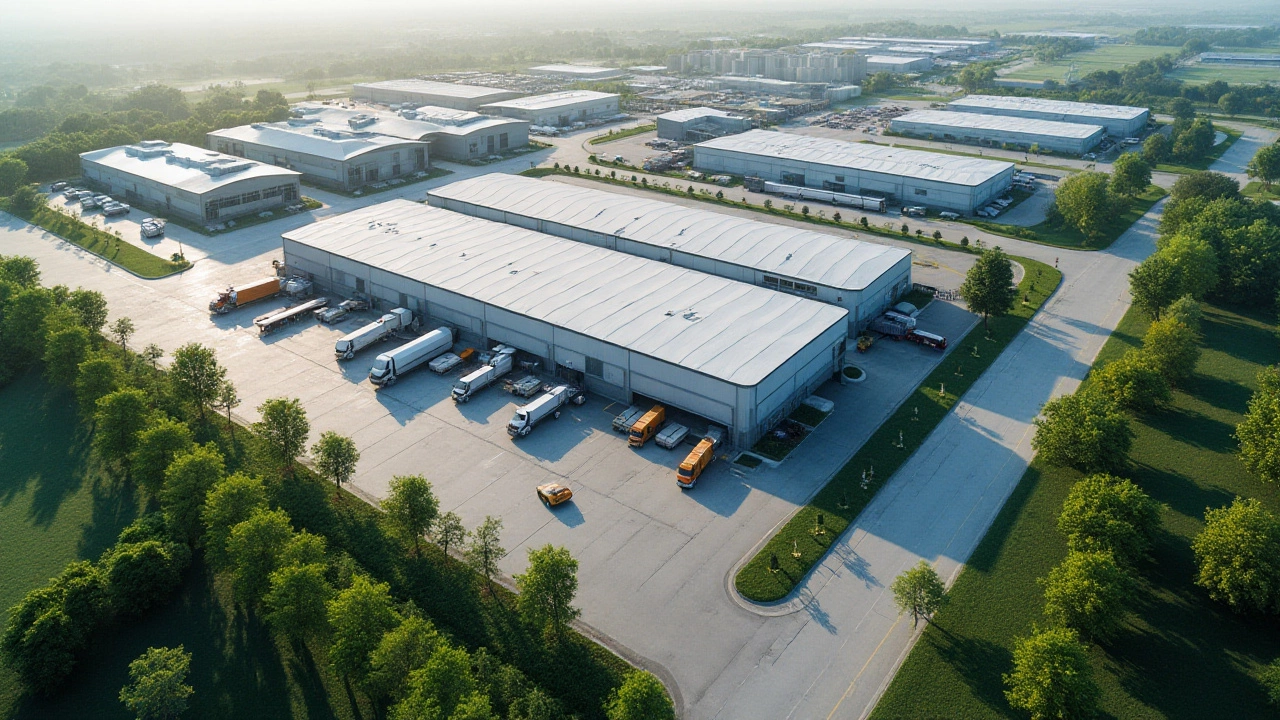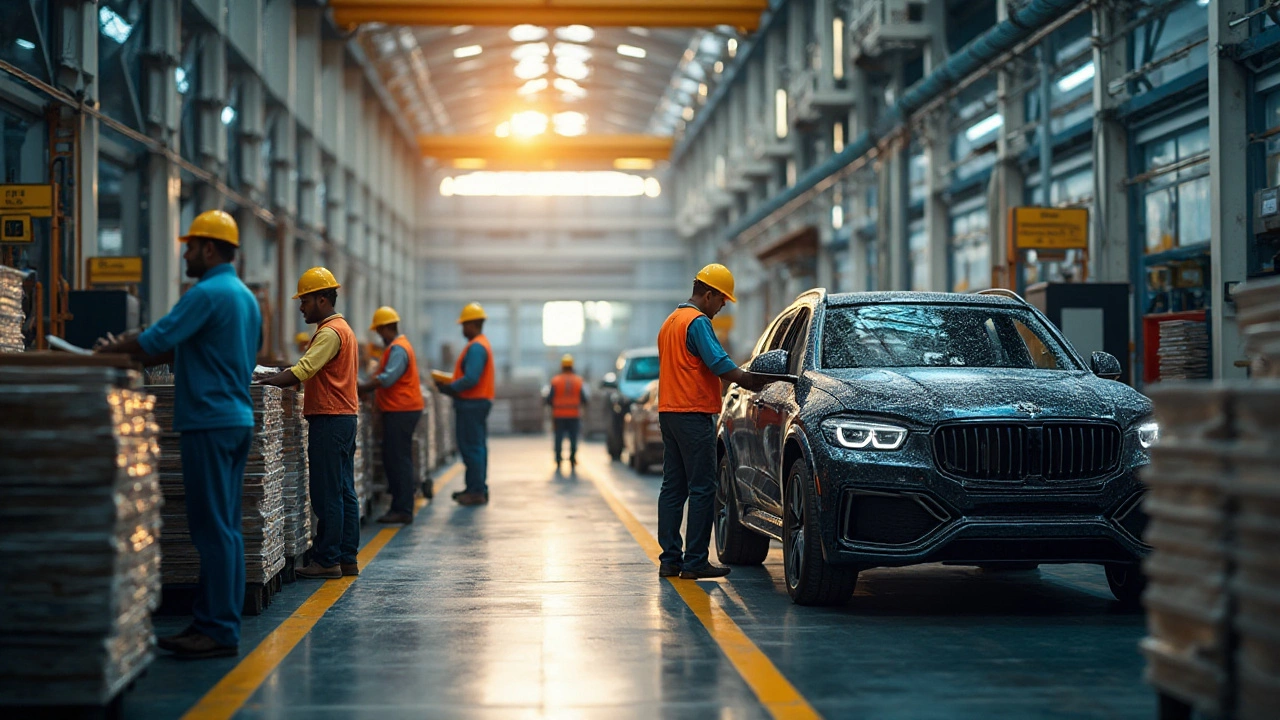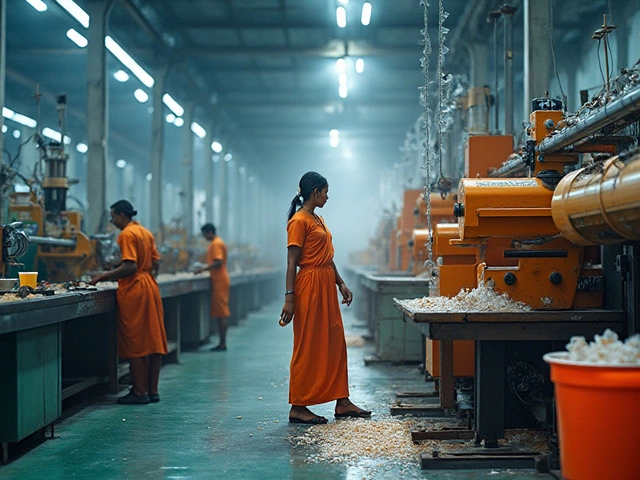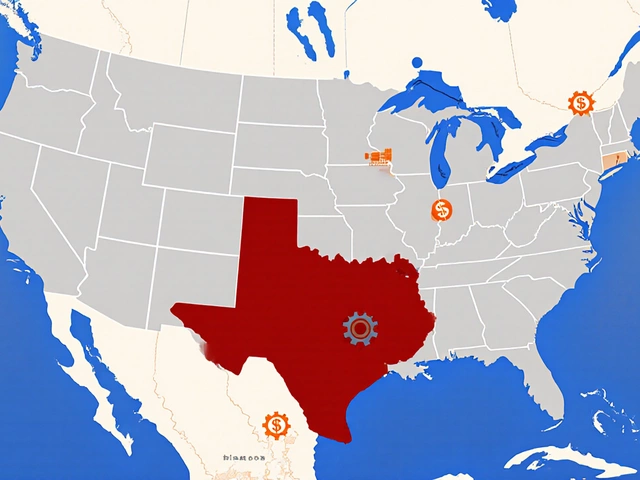The manufacturing landscape in the United States is transforming in exciting ways as we venture further into 2025. With technological advancements and a shift towards sustainable practices, certain states are accelerating their manufacturing capabilities.
Not all states are experiencing this boom equally. Some have tapped into new markets and innovations that set them apart, unlocking unprecedented opportunities for the economy and for startups. But what exactly makes these states the fastest-growing in manufacturing? Let's delve into the factors that fuel this growth, from government incentives to workforce dynamics.
Whether you're considering launching a startup or expanding an existing production facility, understanding these state-specific growth patterns can play a pivotal role in your decision-making process. Here, we explore the standout states in this industry surge and what makes them appealing hubs for new manufacturing ventures.
- U.S. Manufacturing Resurgence
- Breakout States in Manufacturing
- Factors Driving Growth
- Opportunities for Manufacturing Startups
- Future Predictions and Trends
U.S. Manufacturing Resurgence
In recent years, the U.S. manufacturing sector has shown signs of resurgence that many had not anticipated. A combination of technological advancements, policy changes, and shifting market demands have brought about this transformation. The pandemic acted as a catalyst, laying bare the vulnerabilities in relying heavily on global supply chains. As consequences unfolded, many companies began to reconsider their production strategies. This realignment towards domestic production has paved the way for an unexpected revival in certain regions. Gradually, the allure of offshoring diminished, as businesses saw the value in resilience and local manufacturing.
One of the pillars supporting this resurgence is innovation. American manufacturers are leaning heavily into technologies such as automation, artificial intelligence, and the Internet of Things (IoT). By adopting these advanced systems, they are not only boosting productivity but also enhancing quality and efficiency. The emphasis on automation is reshaping how work is done, allowing manufacturers to meet rising demands without sacrificing speed or precision. In many ways, these technological leaps are closing the gaps brought on by the global competition that once seemed unbeatable.
"Manufacturing's future is not about brawn; it's about brains," noted Juliet Scott-Croxford, a tech industry analyst. Her statement underscores the critical role of innovation in revitalizing production landscapes across America.
Moreover, state governments have played an instrumental role in spurring manufacturing growth. By introducing favorable policies and offering incentives like tax breaks and grants, they have turned their regions into fertile grounds for production enterprises. This trend is particularly noticeable in states that have historically not been associated with traditional manufacturing, as they now compete fiercely to attract new facilities and investments. The budding ecosystem of support has created a cycle where thriving startups fuel further advancements, making it an attractive proposition for prospective businesses.
The impact of this movement is reflected in changing workforce dynamics. As the sector adapts, so too does the need for skilled labor. This shift is evident in the proliferation of training programs that focus on equipping workers with the skills required to operate modern machinery and technologies. Communities are responding by re-establishing career pathways and upskilling initiatives, ensuring that the workforce is well-prepared for the demands of contemporary manufacturing jobs. This effort to develop a robust local talent pool is proving to be as important as the advances in technology themselves.
The statistical revival of manufacturing is potent. According to a 2023 report, the sector has seen its strongest growth in nearly three decades, with particular spikes in the production of electronics, automotive parts, and pharmaceuticals. Employment rates have correspondingly improved, with many states reporting significant upticks in manufacturing jobs. As these numbers continue to rise, so do the economic prospects for communities that have embraced this resurgence. The combination of government initiative, technological infusion, and workforce readiness creates a harmonious triad propelling the U.S. manufacturing industry forward in 2025.
Breakout States in Manufacturing
The race to become the leading manufacturing hub in the United States is heating up, with several states emerging as front-runners. One such state that has made significant strides is Texas. Known for its vast industrial space and rich resources, Texas has attracted numerous tech and energy companies. This boom is aided by the state's favorable tax policies and business-friendly environment, which have drawn in manufacturing startups keen on tapping into lucrative markets. Another standout isn’t far behind — Florida. The Sunshine State has seen an influx of aerospace and electronics manufacturing, thanks to its strategic location and access to international markets.
Meanwhile, Tennessee is quietly making its way into the conversation as a manufacturing powerhouse. With a strong automotive industry presence, it has attracted major players like Ford and General Motors, creating a hub for manufacturing prowess west of the Appalachian Mountains. In addition, the state’s investment in vocational training programs ensures a steady stream of skilled labor, which is crucial for startups looking to hire locally. With a diverse economy and supportive local government initiatives, Tennessee provides a fertile ground for manufacturing growth.
The Rust Belt is also seeing a revival, with states like Michigan leveraging their historical expertise in automotive and machinery manufacturing. Investments in clean energy and new technologies have penned a new chapter for Michigan factories. Indiana shares a similar narrative, with its diversified manufacturing sector offering everything from pharmaceuticals to transport equipment. A unique aspect of Indiana's resurgence is its emphasis on advanced manufacturing techniques, putting it at the forefront of innovation.
California, despite higher operational costs, remains a giant in the manufacturing space, particularly in the realms of technology and aerospace. Innovations born in Silicon Valley often require prototypes and parts developed by California's manufacturing sector, which continues to fuel its growth. The state's commitment to sustainable manufacturing practices sets it apart and attracts environmentally-conscious startups. "California has always been and continues to be a leader in manufacturing innovation," said the Governor’s Office of Business and Economic Development in a recent report.
"Manufacturing is the backbone of America, and these breakout states showcase what can be achieved with ambition, innovation, and investment in people," says John Evans, a renowned economics professor.
Driven by complex factors including policy, geography, and talent availability, these states exemplify the diverse landscape of American manufacturing. Understanding the dynamics at play in these leading regions can offer valuable insights for those seeking opportunities in this evolving sector. As manufacturing in the U.S. finds its stride, these states provide prime examples of how industry can flourish through the perfect mix of resources, strategy, and community support.

Factors Driving Growth
As the manufacturing sector enjoys a vibrant resurgence, certain states are racing ahead, fueled by a unique confluence of factors. At the heart of this growth are emerging technologies such as automation and artificial intelligence, which streamline production processes and increase efficiency. States that embrace these innovations are setting themselves apart as leaders. Manufacturers who focus on optimizing production with cutting-edge tools are finding that the upfront investments quickly pay off in terms of both speed and quality.
Another powerhouse behind this expansion is the strategic implementation of favorable state policies. Many states have introduced tax breaks, grants, and incentives intended to attract and retain manufacturing businesses. These initiatives not only reduce operational costs but also spur investment in infrastructure, providing a solid foundation for sustained growth. The impact of these policies cannot be overstated, as they provide a competitive edge to businesses considering their next base of operations.
"Manufacturers are twice as likely to expand their operations in states with favorable tax conditions," said Matthew Lee, an industrial economist at the U.S. Manufacturing Institute. "This has been a game-changer for states like Texas and Indiana."
The availability of a skilled workforce is crucial too. Educational institutions in these booming states often partner with manufacturing companies to tailor programs that develop industry-specific skills. This collaboration ensures a steady supply of talented individuals ready to meet the sector's demands. Emphasizing vocational training and apprenticeships has proven beneficial, enabling these states to meet the growing labor demands with locally sourced talent.
Investment in Sustainable Practices
Environmental concerns have reshaped the manufacturing domain, pushing states to adopt greener practices. Those leading in the adoption of sustainable energy sources, waste reduction initiatives, and eco-friendly technologies are at the forefront of the industry's expansion. This shift is not just a boon to the environment but a driver of economic benefits, as it attracts businesses keen on reducing their carbon footprint while benefiting from potential cost savings.
Investment in transportation and logistics infrastructure also plays a significant role. States with robust highway systems, rail connections, and proximity to major ports facilitate easier distribution of goods, making it logistically advantageous for companies to set up shop. Efficient transportation not only shortens delivery times but also decreases costs, enhancing the competitive edge these states have in the domestic and global markets.
Global Trade Dynamics
The international scene offers another layer of influence. Tariff changes, trade agreements, and export opportunities can significantly impact state manufacturing growth. States with ports or those aligned with trade routes often see higher levels of activity as they become gateways for international commerce. They leverage their geographical advantages to boost exports and import-related activities, bringing additional prosperity to the local economy.
Opportunities for Manufacturing Startups
The resurgence of manufacturing in the United States is a golden opportunity for those looking to establish startups in the sector. This revolution is powered by a mix of innovative technology, favorable policies, and an eager market that is ready to embrace new solutions. The potential for growth is immense, especially in those states that are becoming prime destinations for manufacturing expansion. Thanks to state incentives, emerging technological hubs, and a shift towards sustainable production methods, entrepreneurial spirits have diverse opportunities to explore and capitalize.
One key factor driving these opportunities is the availability of state-level incentives designed to attract and nurture new businesses. Many states offer tax breaks, grants, and subsidies targeted at manufacturing startups, making it financially viable to set up shop. For instance, Texas launched its Manufacturing Assistance Program, specifically to streamline the process for startup manufacturers. This move is complemented by access to skilled labor pools emerging from local technical colleges, ensuring that new ventures have a workforce ready to hit the ground running.
Technology also plays a transformative role in opening up new avenues for manufacturing startups. The rise of Industry 4.0, characterized by smart factories and IoT integration, is allowing companies to innovate in ways that were previously unimaginable. Startups can now leverage advancements such as 3D printing and AI to cut down on production costs and time while enhancing product customization. According to the National Institute of Standards and Technology, these technologies are enabling a new wave of personalized manufacturing, allowing businesses to cater to niche markets like never before.
The growing emphasis on sustainability presents another fertile ground for manufacturing entrepreneurs. Consumers and businesses alike are increasingly prioritizing eco-friendly practices. Startups that develop innovative, green manufacturing solutions can tap into this expanding market. By adopting sustainable processes and materials, not only do they appeal to environmentally conscious consumers but also benefit from regulatory incentives aimed at reducing carbon footprints. A report by the U.S. Green Building Council highlights that green manufacturing can lead to a significant reduction in operating costs, facilitating a faster return on investment.
Networking and collaboration hubs offer yet another benefit to startups in manufacturing. Many states boast thriving innovation ecosystems that connect startups with mentors, investors, and partners. These ecosystems often cluster around urban areas with universities and research institutions, creating a vibrant community of innovators and thought leaders. Being part of these networks can provide startups with the insights, resources, and support needed to tackle challenges head-on, driving sustainable growth and success.
For entrepreneurs eager to venture into the manufacturing sector, understanding state-specific growth trends and aligning with market demands can set the stage for a successful enterprise. The landscape is ripe with potential for those ready to embrace new technologies and sustainable practices, and each state offers unique advantages. Taking the time to explore these opportunities can uncover the perfect alignment between a startup's goals and a state's strategic direction, creating a roadmap for thriving in the fast-evolving world of manufacturing.

Future Predictions and Trends
As we peer into the horizon of 2025 and beyond, the manufacturing industry is poised for a transformation unlike any we've seen before. This shift is driven largely by the increased demand for sustainable production practices and the integration of digital technologies like artificial intelligence and the Internet of Things. These technologies are enabling production lines to become smarter, more efficient, and capable of producing high-quality goods at unprecedented speeds. This is essential not just for keeping up with global competition, but also for meeting the evolving needs of consumers who prioritize sustainability and speed.
One of the key areas to watch is the rise of onshoring, a practice where companies bring manufacturing processes back to their home countries. This trend has been catalyzed by disruptions in global supply chains, notably due to geopolitical tensions and pandemic-induced challenges. By setting up operations closer to major markets, these companies are not only reducing shipping costs and times but also boosting local economies. Moreover, consumers' preference for 'Made in the USA' products is incentivizing companies to establish their manufacturing bases domestically.
Manufacturing startups are also finding ample opportunities to flourish in this environment. Fuelled by state-led initiatives aimed at fostering innovation, these new ventures are seizing the chance to tap into niche markets and cater to specialized demands. Another factor contributing to an optimistic future for manufacturing is the emphasis on resilience. Businesses have recognized the need to anticipate potential disruptions and build agile operations that are adaptable to change. This often involves diversifying production sites and investing in redundancies that ensure stability under various circumstances.
"Investing in advanced manufacturing technologies and embracing sustainability will be the primary drivers for competitive advantage over the next decade," says industry analyst John Randall. "States that lead in fostering these drivers are likely to see continued growth in their manufacturing sectors."
In terms of specific technology trends, 3D printing and robotics are becoming more prevalent across industries. These technologies offer a level of customization and efficiency that was previously unattainable. For instance, 3D printing enables rapid prototyping, reducing the time and cost associated with traditional methods. They also allow for the customization of products in ways that were once unimaginable. With the help of such innovations, manufacturers are able to cater to the personalized needs of customers and experiment with unique designs.
Notably, the adoption of green practices is a trend that continues to gain traction across the manufacturing sector. As awareness of environmental impact grows, businesses are compelled to investigate energy-efficient production methods and reduce waste. Many companies are investing in renewable energy solutions and reexamining their supply chains to minimize their carbon footprint. There is a growing recognition that aligning sustainability objectives with production goals not only benefits the planet but also resonates with environmentally conscious consumers, adding value to a company’s brand.
We can also expect to see more states introducing legislation and policy incentives that drive technological adoption and green manufacturing processes. Many states are already offering tax breaks and grants to companies that invest in sustainable practices and technologies, making them attractive destinations for manufacturing growth. These incentives are an essential component of what determines which states emerge as leaders in U.S. manufacturing. As we move forward, states will likely continue to leverage these strategies to attract more businesses and foster a robust manufacturing ecosystem.






